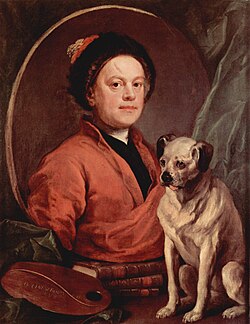1720s
- Tatton Coat of Arms (early) [1]
- Benefit ticket for Spiller (1720?) [2]
- Shop card (1720)—advertising Hogarth's own engraving shop [3]
- Shop card for Hardy (early) [4]
- Funeral ticket (c.1721-36) [22]
- Shop card for Ellis Gamble (c.1723 or 1728) [23]
- Impression from a tankard belonging to the Clare Market Artists Club (early) [25]
- Kendal Arms (1723 or later) [26 (27)]
- Self-portrait with two figures and two cupids (1720)
- Emblematical Print on the South Sea Scheme / The South Sea Scheme (c.1721) [43]
- Fifteen illustrations for Aubrey De La Montraye's Travels (1723) [28–42]
- Seven small prints for Apuleius's Golden Ass (1724)
- The Lottery (1724) [53]
- The Mystery of Masonry brought to Light by ye Gormogons (1724) [55]
- The Bad Taste of the Town / The Taste of the Town / Masquerades and Operas (1724) - Hogarth's first attempt to publish his own satirical print, an attempt frustrated by the printmakers' monopoly [44]
- Seven illustrations for Gildon's New Metamorphosis (1723) [45–51]
- A Just View of the British Stage (1724) [57]
- Royalty, Episcopacy, and Law / Some of the Principal Inhabitants of the Moon (c.1724-25) [56]
- Five illustrations for La Calprenede's Cassandra (1725) [58–62]
- A Burlesque on Kent's Altarpiece at St. Clement Danes (1725) [63]
- Two illustrations for Milton's Paradise Lost (1725) [64–65]
- Fourteen illustrations for Beaver's Roman Military Punishments (1725) [66–79] [1]
- Sign for a Paviour (c.1725) [2]
- The Carpenter's Yard (c.1725) [3]
- The Doctor's Visit (c.1725) [3]
- Seventeen Small Illustrations for Samuel Butler's Hudibras (1726)—engraved in 1721 they were published alongside the twelve large illustration in the 1726 edition [5–21]

- Twelve illustrations for Samuel Butler's Hudibras (1726) [82–93]
- Sancho's Feast (possibly before the illustrations of Don Quixote, probably before 1733) [100]
- Six illustrations for Cervantes’ Don Quixote (c.1726) [94–99]
- Frontispiece for Terrae-Filius (1726) [101]
- Twenty-six figures (on two plates) for Blackwell's Compendium of Military Discipline (1726) [102,103]
- Letterhead for Blundell's School, Tiverton (1726) [104]
- Cunicularii / The Wise Men of Godliman in Consultation (1726) - a satire on the "learned" doctors taken in by Mary Toft, a subject revisited in Credulity, Superstition, and Fanaticism [106]
- The Punishment Inflicted on Lemuel Gulliver (1726) [107]
- A Garret Scene (c.1726) [3]
- Shop card for Mrs. Holt's Italian Warehouse (unknown) [106]
- His Royal Highness George, Prince of Wales (before 1727) [54]
- Masquerade Ticket (1727) [108]
- Frontispiece to Leveridge's Collection of Songs [110]
- Frontispiece to Cooke's Hesiod (1727) [111]
- The Carpenter's Yard (1727?)
- Music Introduced To Apollo By Minerva (1727?) [109]
- Benefit ticket for Milward (1728) [112]
- Henry the Eighth and Anne Boleyn (1728–29) [113]
- The Great Seal of England (1728–29) [114]
- Two illustrations for Theobald's Perseus and Andromeda (1729) [115,116]










